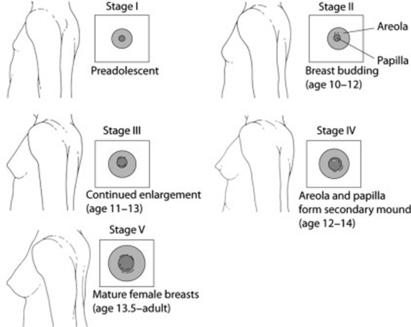Chapter 15 The Healthy Adolescent
Adolescence is the period of transition between childhood and adulthood. Although often thought to be tumultuous, most adolescents navigate this transition with few difficulties. The physical changes that occur during this period are referred to as puberty, the psychosocial changes as adolescence. Special consideration must be given to ethical issues such as autonomy and confidentiality (see Chapter 6). Health supervision for the adolescent is discussed in Chapter 11.
What Is Sexual Maturity Rating?
SMR of breasts (Figure 15-1)
SMR I: The breasts are preadolescent. There is elevation of the papilla only.
SMR II: A small mound is formed by the elevation of the breast and papilla. The areolar diameter enlarges.
SMR III: There is further enlargement of the breast and areola with no separation of their contours.
SMR IV: There is projection of the areola and papilla to form a secondary mound above the level of the breast.
SMR V: The breasts resemble those of a mature female, as the areola has recessed to the general contour of the breast.

Figure 15-1 Sexual maturity rating (SMR) of breast development in females.
Used with permission of Ross Products Division, Abbott Laboratories Inc, Columbus, OH. From Johnson TR, Moore WM, Jefferies JE: Children are different: development physiology, ed 2, Columbus, OH, 1978, Ross Products Division, Abbott Laboratories Inc.
SMR of pubic hair (Figures 15-2 and 15-3)
SMR I: There is no pubic hair.
SMR II: There is sparse growth of long, slightly pigmented, downy hair, straight or only slightly curled, primarily at the base of the penis or along the labia.
SMR III: The hair is darker, coarser, and more curled. The hair spreads over the junction of the pubes.
SMR IV: The hair is adult in type but covers a smaller area than in the adult. It does not extend onto the thighs.
SMR V: The hair is adult in quantity and type. It extends onto the thighs.

Figure 15-2 Sexual maturity rating (SMR) of pubic hair development in females.
Adapted from Neinstein LS: Adolescent health care: a practical guide, ed 2, Baltimore, 1991, Urban & Fischer Verlag.
SMR of male genitalia (Figure 15-3)
SMR I: The penis, testes, and scrotum are of childhood size.
SMR II: Enlargement of scrotum and testes, but penis usually does not enlarge. Scrotal skin reddens.
SMR III: Further growth of testes and scrotum, with enlargement of penis, mainly in length.
SMR IV: Further growth of testes and scrotum with increased size of penis, especially in breadth.
When Is Puberty Too Late?
Males whose testicular length has not exceeded 2.5 cm by age 14 have delayed puberty.
Stay updated, free articles. Join our Telegram channel

Full access? Get Clinical Tree



